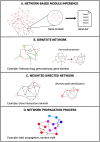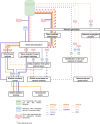Reconciling multiple connectivity-based systems biology methods for drug repurposing
- PMID: 40736744
- PMCID: PMC12309248
- DOI: 10.1093/bib/bbaf387
Reconciling multiple connectivity-based systems biology methods for drug repurposing
Abstract
In the last two decades, numerous in silico methods have been developed for drug repurposing, to accelerate and reduce the risks about early drug development. Particularly, following Connectivity Map, dozens of distinct data-driven methods have been implemented to find candidates from the comparison of differential transcriptomic signatures. Interestingly, there have been multiple proposals to integrate available knowledge using systems biology databases and adapted algorithms from the network biology research field. Despite their similarities, these methods have been formulated inconsistently over the years, even if some of them are fundamentally similar. The aim of this review is to reconcile these integrative methods, focusing on elucidating their common structures while underlining the specificities of their strategies. To achieve this, we classified those methods into two main categories, provided schematic workflow representations, and presented a homogenized formulation for each.
Keywords: connectivity score; data integration; differential expression signature; drug repurposing; system biology.
© The Author(s) 2025. Published by Oxford University Press.
Figures



Similar articles
-
The Black Book of Psychotropic Dosing and Monitoring.Psychopharmacol Bull. 2024 Jul 8;54(3):8-59. Psychopharmacol Bull. 2024. PMID: 38993656 Free PMC article. Review.
-
Assessing the comparative effects of interventions in COPD: a tutorial on network meta-analysis for clinicians.Respir Res. 2024 Dec 21;25(1):438. doi: 10.1186/s12931-024-03056-x. Respir Res. 2024. PMID: 39709425 Free PMC article. Review.
-
Factors that influence participation in physical activity for people with bipolar disorder: a synthesis of qualitative evidence.Cochrane Database Syst Rev. 2024 Jun 4;6(6):CD013557. doi: 10.1002/14651858.CD013557.pub2. Cochrane Database Syst Rev. 2024. PMID: 38837220 Free PMC article. Review.
-
[Volume and health outcomes: evidence from systematic reviews and from evaluation of Italian hospital data].Epidemiol Prev. 2013 Mar-Jun;37(2-3 Suppl 2):1-100. Epidemiol Prev. 2013. PMID: 23851286 Italian.
-
Falls prevention interventions for community-dwelling older adults: systematic review and meta-analysis of benefits, harms, and patient values and preferences.Syst Rev. 2024 Nov 26;13(1):289. doi: 10.1186/s13643-024-02681-3. Syst Rev. 2024. PMID: 39593159 Free PMC article.
References
-
- Austin D, Hayford T, Kile J. et al. Research and Development in the Pharmaceutical Industry. Washington, DC: Congressional Budget Office; 2021 April. https://www.cbo.gov/publication/57025
Publication types
MeSH terms
LinkOut - more resources
Full Text Sources

